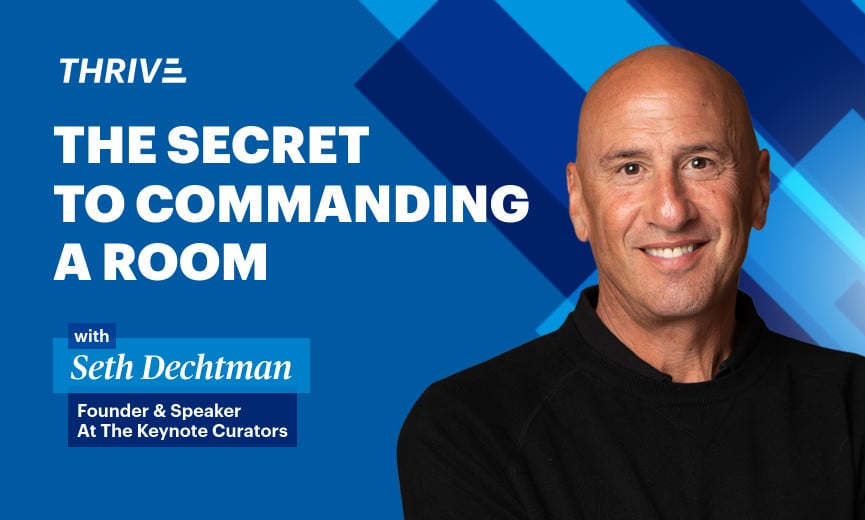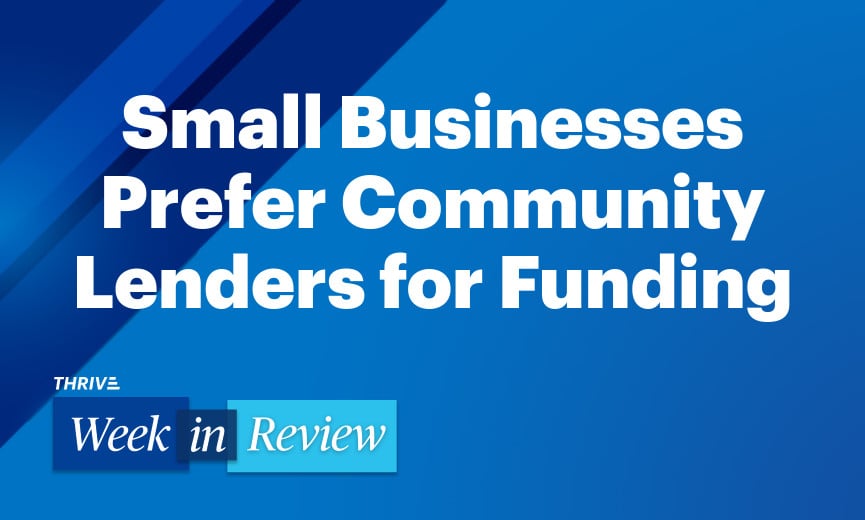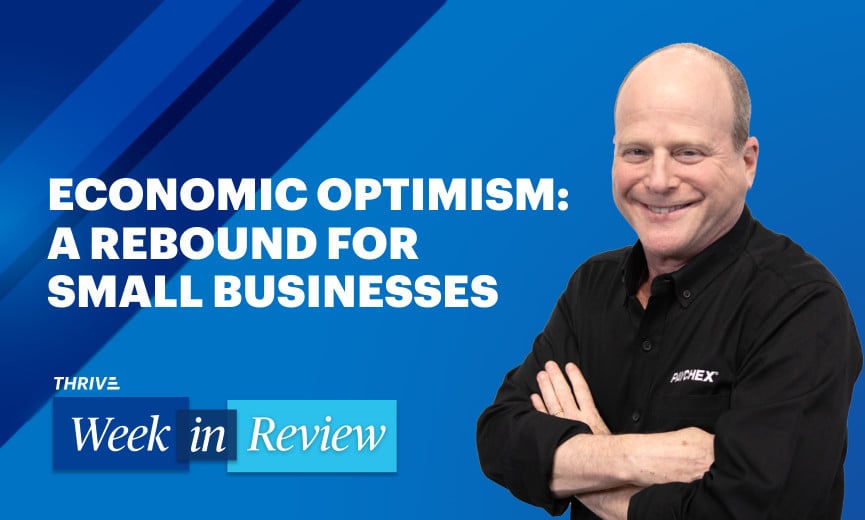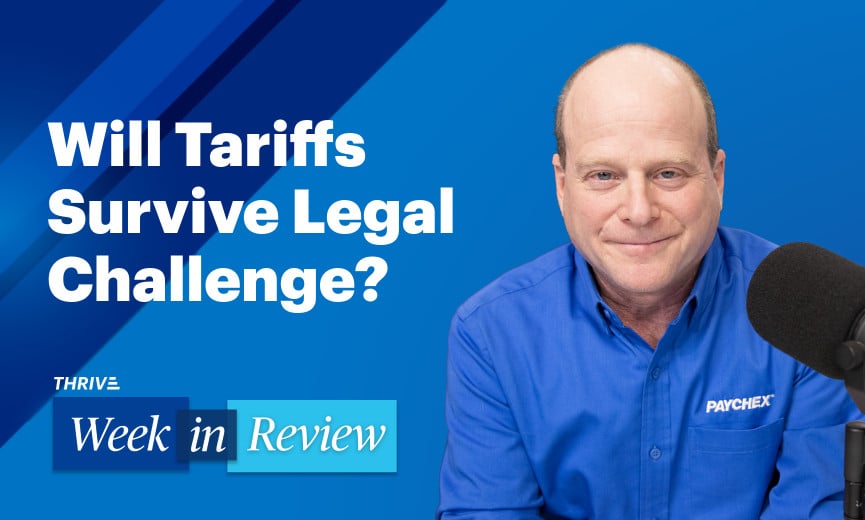- Thrive
-
Season
5Episode45
Benefits Manager Tami Tillery on Navigating the Future of Employee Benefits
Podcast •
Watch
Summary
This episode features a conversation between Gene Marks and Tami Tillery, a Senior Benefits Manager at Paychex as they dive into the top questions asked during a recent webinar, Sustainable Benefit Strategies for Every Business Stage. Tami and Gene discuss the changing landscape of employee benefits and healthcare strategies for businesses, focusing on healthcare benefits in rural areas and finding a balance between cost and quality. They also emphasize the role of technology, like AI and digital platforms, in improving employee engagement and managing benefits more efficiently.
Topics include:
00:00: Episode Preview
00:41: Overview of the "Sustainable Benefit Strategies" webinar
01:28: Rising healthcare costs insights
02:27: Strategies for rural employers
05:19: Healthcare costs and age groups
07:10: How to pick insurance plan designs from different carriers
10:21: Feasibility and advice for small businesses to offer group insurance
14:33: Getting the right benefits support
20:25: Strategies for rural employers balancing costs and quality
23:50: Predictions on future benefits trends
30:17: Wrap up and thank you
Watch the on-demand webinar, Sustainable Benefit Strategies for Every Business Stage.
Have a question for upcoming episodes or a topic you want covered? Let us know!
View Transcript
Gene Marks:
You're absolutely right about AI. I think that will...
Tami Tillery:
The next 10 years is going to be a game changer. The things that we're going to see introduced into the market on how to help support overall well being. And I'm saying overall well being, Gene, not just any one particular facet. It's going to be amazing.
Gene Marks:
Yeah, it is. I guess employers are going to have, yeah, employers are going to have like issues with privacy there. You know, if it's their own internal systems, you know. Correct. Or their AI systems giving wrong advice or bad advice to their employees, you know, like I can see those being issues for employers, but I don't know. Net net. I think it would be like, you know, another huge benefit.
Announcer:
Welcome to THRIVE, a Paychex Business Podcast. Your blueprint for navigating everything from people to policies to profits. And now your host, Gene Maks.
Gene Marks:
Hey everybody, it's Gene Marks. And welcome back to another episode of the Paychex THRIVE podcast. Thank you so much for joining us. I'm here with Tami Tillery. Tami is a senior benefits manager at Paychex. We want to talk about Tami, And Tami has appeared on the podcast before. But about a webinar that was recently done which all you guys watching and listening can, can go to this webinar. It's called Sustainable Benefit Strategies for Every Business Stage. It's an on-demand webinar now and there will be a link to it in the show notes. But basically, you know, it was mostly about health care. I mean, health care costs, you know, in the write up to the webinar, Tami, it said that health care benefit costs are projected to rise nearly 6% in 2025. And I know different people have different comes from different places, but numbers I was reading was like 9%. And I'm reading like health care costs could be going up another 9%, you know, next year. I mean, it is like a big deal. So this webinar, for all of you guys watching or listening to this, go to this webinar. Sustainable Benefit Strategies for Every Business Stage. It was a great panel discussion on how to, to manage these costs. But during the, you know, course, the webinar people were submitting questions. The panelists did not have time to get to these questions. So Tami, I'm going to, we've kind of grouped them all together, a bunch of them. And I want to just fire off some of these questions about health care, that health care benefits, hopefully you can, you can knock them out of the park. Is that fair enough?
Tami Tillery:
Sounds great.
Gene Marks:
Thank you all right, so let's do this. So I'm looking down the first question that came in. How can employers in rural or underserved has overcome the unique challenges of offering healthcare benefits like limited provider access, rising premium costs, employee resistance to telehealth while still maintaining affordability and quality? The takeaway is, and that question is, how could rural or underserved areas, underserved area employers deal with healthcare benefits for their employees? Give me some of your thoughts.
Tami Tillery:
Yeah. So take a moment and picture this. You're running a small business in a town where the nearest hospital is 45 minutes away. That itself is the reality for many rural employers. One of the biggest, biggest challenges is access. There just aren't enough doctors or clinics nearby in that specific area. And even though telehealth sounds like a great solution, many rural areas still don't have reliable Internet to support it. So access is one thing, but then there's cost, Gene. Smaller businesses often operate on tighter margins, so offering competitive health benefits can be very tough for some folks. And with fewer insurance providers in rural markets, there's less competition, which means higher premiums and fewer choices. So you take a step back and think, what is a rural employer to do? Well, the first thing we would suggest is really get creative and leverage telehealth. Because even if Internet access is spotty, some employers are still setting up dedicated spaces with reliable connections where employees can access virtual care. Now, it's not perfect, but it's a step forward. Right. And we also don't want to forget about the alternatives to virtual care, such as maybe setting up an on site or near site clinic, even if it's just like a nurse practitioner coming in a few days a week. There's also a big thing happening in rural areas right now where they're setting up mobile health units. Think of it like a doctor's office on wheels that visits remote areas on a set schedule. So those are a couple of things you can do. And then another creative one that we like to throw in there is what's called health care navigators. Now, these are professionals who help employees find care, schedule appointments, and really understand the benefits that are being offered to them. It's that personal touch that can really make a big difference, especially for folks who are hesitant to engage with digital platforms. So leveraging that telehealth creatively is the first one. And there's a few other things we can talk about as well, Gene, if you'd like.
Gene Marks:
No, it's good. So telehealth, virtual care, some of these mobile, mobile units that provide these care. This great, great solutions for people that are in the rural, rural areas of this country. Okay, let's talk about the next question. When it comes to averaging healthcare costs across employees of different age groups, how does that work in practice? For example, how would a $500 average premium impact a 26 year old versus a 55 year old? Why would somebody even ask this question, Tami, to start with?
Tami Tillery:
Well, you know, let's break down something that confuses a lot of people, Gene. How healthcare premiums work across different age groups.
Gene Marks:
Right?
Tami Tillery:
So, say your company offers a health plan with an average premium of $500 a month. That doesn't mean that everyone's health care costs the same. A 26-year-old probably doesn't go to the doctor as much, while a 55-year-old may have more regular visits, maintenance, drugs that they're taking, and so on. But in many workplace plans, everyone pays the same rate, and that's called a composite rate. Basically, the insurance company looks at the whole group. They spread out the cost evenly so that the younger folks are helping balance out the higher cost of the older population. Now, I get it. It might feel unfair if you're young and healthy, but it does help keep the plan simple and stable for everyone involved. And think about it. One day you're going to be in that older population and you're going to be the one needing more care. And that same system will work in your favor. So the next time you hear average premium, just know it's not about what you use. It's about what everyone in your group needs.
Gene Marks:
All right, And you know, by the way, when that day comes, Tami, you realize we will all have AI chips embedded all over our bodies that will just be fixing our problems anyway.
Tami Tillery:
But fair enough, that's the goal, right, Gene? That's the goal. I want to be completely rebuilt in a better model.
Gene Marks:
And it shouldn't cost $6 million. That's, that's a reference to like a 1970s TV show. Okay, let's go to the third question that was asked by one attendees of this webinar. Tami, what does it mean to pick plan designs from carrier to carrier? How can businesses make informed decisions when selecting plans? So what does that mean?
Tami Tillery:
So think about different insurance companies. Think about companies like Aetna, Blue Cross and Blue Shield United Healthcare. They all offer different types of health plans. Each one has its own mix of cost coverage features. Some plans have low monthly premiums, but they have high deductibles. Others might cost more. Each month, but they offer more coverage up front. So when a business is choosing a plan, they're not just picking a company to work with, they're picking a specific plan that fits their team's needs and the company's budget. So to make a smart choice, I always recommend a few simple tips. First, first, you gotta know your team. Are they mostly young and healthy or do they need regular care? You need to look at the full cost, not just the monthly premium, but also drill down into those plan designs and look at what are the deductibles, what are the co pays, what are the coinsurance, and then also as best practice, check your doctor list, make sure your employees, doctors are in network, because we all know in network is going to be the biggest bang for your buck. And that's where we direct most employees to utilize. And then of course, ask questions, whether it's a PEO, a broker, an advisor, all of these different people can help compare plans side by side so that at the end of the day, it's about finding the right balance between cost and coverage for your business and your specific population.
Gene Marks:
I have a question for you on this, sort of unrelated to this, when we're talking about figuring out your advisors to determine what the cost would be of each plan, a lot of my clients, what they do is they take like a sampling of employees from their business and they basically say, okay, well what would it, what would this plan cost this person, you know, and what would this plan cost that person based on their age situation, family, you know, whatever, you know, And I've always been like a little like wary of that just from like a HIPAA responsibility or privacy thing. Do you know what I mean? And I don't know if you have any thoughts on that. Like, is that like a good approach?
Tami Tillery:
Or, you know, we never want to isolate out any one individual because here's the deal. Everybody has their own health care needs, right?
Gene Marks:
Right.
Tami Tillery:
They all have their own circumstances going on. And so we never want to isolate that particular individual or that particular family. And that's why when you go to market, it is looked at the group in totality. So you really don't, as an employer, it's best practice for you not to get involved in that personal health information, not to get involved in their medical situations. Really, it's going to market and saying, look, this is my census. What can I be quoted based on this census in its totality? And that's what they're looking at, is at an average of what's your population look like what's utilization? What's its forecasting? So that they can give you a fair price based on that information and not drilling it down to any one person.
Gene Marks:
All right, great advice. All right, next question, which is definitely relevant for a lot of my clients. Is it feasible, Tami, for small businesses with just a few employees to get group health insurance? You know, and what practical advice do you have to help them weigh the pros and cons when designing a plan for just maybe like one to four people?
Tami Tillery:
So the short answer is yes, Gene, but it's really tricky because Groot health insurance itself is usually designed for businesses with at least a few employees. Some carriers have specific requirements, as you're probably aware of. Sometimes they just need two, sometimes they need five. But even then the cost can be high because it's such a small population. So for like a solo business owner, individual health plans or marketplace options might be more realistic and gentle on the pocketbook. But if you are looking at getting a small business insurance, there are some pros and cons like you talked about. The pros are if you can get it, it is going to help you attract and retain good talent. It's going to show that you care about your team's well being. It's going to offer some tax advantages for the business overall. So those are all great things. But we also have to look at the flip side. It could potentially be expensive, especially with a small group, depending on how you source out those plans may limit the plans you have available to choose from. And there may be more paperwork and compliance to manage depending on what direction you go. Now if you've got a small team of, say three or four people, you're thinking about offering group health insurance. Work with a broker or an advisor. Look at a PEO, look into level funded or association type plans. Maybe you just want to consider supplemental benefits like dental, vision, life, disability and maybe not focus on major medical. Maybe just get some of those other things out there so that you have something to offer to your folks that don't necessarily require an employer contribution. So those are the types of things. And really find out from your team, you know, especially that small of a team, what matters to them. Sometimes it's a simple plan with solid coverage, sometimes they have a medical solution and they're looking for all the other stuff that may be more beneficial, cost wise. So it's doable. It just takes a little strategy and the right support to make it happen.
Gene Marks:
Good. All right, that's great. All right, next question that got raised actually is it's actually a Paychex related question. So, you know, hopefully people are watching and listening to this are Paychex customers. And if you're not, this gives you an indication of what like a Paychex does. So here's the question. Is it possible to push benefits like the Employee Assistance Program and Working Advantage, it's called, to new employees electronically through Paychex? How can this improve employee participation and engagement? So tell us about these programs, Tami.
Tami Tillery:
So, to your point, with platforms like Paychex, employers can share benefit info electronically during onboarding. The biggest thing is education, right? We want employees to know what benefits are available to them so that they actually have an opportunity to utilize it. This means that when a new hire logs in to complete their paperwork, they're also going to see what benefits are available, like medical or supplemental products, maybe financial wellness, maybe discounts on everyday purchases. And this matters because when benefits are easy to find and understand, people, like I said, are more likely to use them. It's all about access, awareness. And if employees don't know what's available or if it's buried in a handbook or in a stack of paperwork, they're likely not going to take as much advantage of it as we would like them to. So we push it with benefits digitally. By making it part of the onboarding experience, you're going to increase visibility and participation and you're also going to show those new hires from day one that you care about them and their well being. And hopefully that leads to better engagement and stronger retention and healthier workplace culture overall.
Gene Marks:
Great. All right. That is great. All right, let's move to the next one. This has to do about getting advice. So again, this was an attendee of this webinar asked what should employers do if they feel they're not getting enough advice or support from their current benefits contact? How can they advocate for better guidance?
Tami Tillery:
Absolutely. And let's be real benefits are confusing, are they not? You know, I always joke around and say, you know, I'm going to try to make this as painless as possible when I'm talking about benefits. Because if you're an employer and you're trying to do right by your team, but you're not getting the advice or the support you need from, say, a benefits contact. It's really frustrating. And so the first thing I tell folks to do is you have to speak up, set up a meeting and clearly explain what's missing from your customer service. Maybe you need more help explaining plan options. Maybe your employees have questions that aren't being answered, be very specific about the kind of support you're expecting. Next up, you want to ask for proactive guidance. A good benefits partner should be bringing ideas to the table, not just reacting. All right? If they're not helping you plan ahead for success or improve engagement, that's going to be a huge red flag for you. And don't be afraid to shop around. You deserve a partner who understands your business and your people. So whether it's a broker, a PEO, a consultant, if they're not adding value, it might be time to explore other options. So whether you're a small startup or a growing enterprise business. Paychex. You know, I talk about Paychex. Paychex has solutions tailored to your business wherever you are in the US to find the right fit for you. And last but not least, advocate for your team. Your employees are relying on you to make benefits work for them. So if something is feeling off, always trust your gut and push for better. Because at the end of the day, benefits aren't just the checkbox anymore. They're a big part of how you take care of your people.
Gene Marks:
I mean, Tami, that's great. That's great advice. I also have to say, like, you know, for most of my clients, you know, I see the good benefits providers, the good brokers, and the ones that aren't that good, you know, I mean, people like, I've seen brokers that sign people up for health insurance, and as long as they're getting their checks every year, they don't really care. It's just, it's like this recurring thing, you know what I mean? And then I've seen brokers that are constantly in touch with their clients and coming up ways and making suggestions to get more value from their health, you know, health insurance, even by saying, like, we should be coming out and giving educational programs or talking directly to your employees or, you know, maybe you should be considering this plan instead of that plan. So I don't know, in this day and age, there are some really, really good HR consultants, benefit providers and brokers that are out there. And you said it. I mean, it's proactive to me is. It is the number one thing, if you are working with somebody that is basically just kind of sitting on their butt, not doing much, there's plenty of other options that are out there for you. And to your point, you know, Tami, it is, this is like you want to get bang for your buck and you also want to provide the best benefits for your employees, your employees and your family. And you're you're kind of disserving them if you were just, you know, taking second best instead of pushing for the best type of, you know, care that you can be getting. So anyway, that's what I'm seeing out, you know, in the wide world. And I'm glad that you bought that. I'm glad you brought that up. All right, let's go to the next one. Let's have. I just have three more questions. Okay. So a visitor or an attendee of this webinar said, how can businesses. We're back to rural areas now. How can they find the right partner or advisor to help them navigate complex benefit decisions? Now, first of all, I just want to make sure this person's asking this question. I mean, you know, yeah, you might be in the middle of Oklahoma, but I'm assuming if you've got the Internet and a phone, you know.
Tami Tillery:
Exactly. Available for them. Absolutely.
Gene Marks:
Right, right. So, talk to me a little bit about.
Tami Tillery:
There's still some support there for you.
Gene Marks:
Right, right.
Tami Tillery:
What I tell folks is, you know, start with a PEO, a benefits broker, an advisor. These are all professionals who help you compare plans, understand the cost, and make sure that what you're offering is the right coverage for your team. And the good news, many of these folks work virtually so you don't need someone local to get great support. They are accustomed to working in a virtual environment and rising to the occasion like you said, and making sure your folks have what they need proactively. And a few tips to find that right fit. Right. Because you do have to shop around. You have to find that right fit. You need to ask local businesses, hey, who do you use? Right? Word of mouth is a powerful thing, especially in these small communities. You want to look for brokers or PEOs that specialize in small or rural businesses. And then you want to interview a few good options. Ask them, how will you support me year-round, not just at renewal time. Right. A good PEO or broker or consultant is going to help you with compliance, employee education, cost control, positioning, all of those things. And then you also want to look at what's their technology look like, because even in rural areas, digital platforms themselves can be a huge difference, especially when we talked about things like onboarding, telehealth, communication. So it's all gene about finding at the end of the day that right partner who will feel like an extension of your team, someone who truly listens, understands your challenges, and brings real solutions to the table.
Gene Marks:
That's great. Okay, next to last question, we're still on rural and underserved areas of the country. So, you know, an attendee of this webinar said, how can employers balance affordability and quality when designing benefits packages for employees in rural areas? Meaning that, you know, you know, if you're from an underserved area, you're from a rural area, maybe your employees really just can't afford the kind of benefits that, that they need to have. So there's, there's like a trade off. I'm going to jump in, I'm going to try, I'm going to try and guess what your response is. And if I'm wrong, I'm wrong. But like, number one is, I would think you want to offer them as many options as possible so they can make those choices. Number two is, and I'm only thinking my own clients that are in, you know, you know, rural areas of this country, education is key. They can learn what their choices are. So speak to that. Am I anywhere near right?
Tami Tillery:
No, you're, you are near, right? Yes. You know, for me, Gene, it's all about balance.
Gene Marks:
Right?
Tami Tillery:
You want to take care of your team, but you also want to watch your bottom line. And how do you do that? How do you do both? Because that's a challenge to do both. You start with what matters most. You talk to your employees, you get a feel for what are they thinking about medical coverage, what's their stance on mental health support, do they want dental and vision? Really focus where your dollars and their dollars are going to have the biggest impact. And then, like you were saying, options. Keep it at a base plan, but then add options. Base your employer contribution on that base plan offering and then allow your employees the opportunity to buy up to other coverages out of their own pocket if they feel that's what them and their family needs. You also want to look at the use of wellness and preventative care type programs, encourage checkups and screenings and healthy habits. Some of these plans that you're going to be looking at even offer discounts for participating in some of these programs. And then also, you know, don't forget about the education. All right, Sometimes the benefits are great, but people don't use them because they don't understand them or they don't remember that they're available to them. So really making sure that clear communication can boost engagement and make this investment for you and them go further. So, long story short, yes, it's possible to offer quality benefits in underserved areas, but it is going to take little creativity, a lot of listening, the right partners, so that you can build a health plan solution that works for your people and your budget. So those are some of the things that I would position.
Gene Marks:
Great. All right. Hey Tami, how long have you been with Paychex now?
Tami Tillery:
Going to age myself, Gene. Totality. I've been with the company almost 20 years.
Gene Marks:
Oh my God. Okay. I actually. Yes, that for a reason. So like you've been with Paychex for the last 20 years. You are a senior benefits manager with this company. So this is your specialty is benefits for your customers, you know, and advising them and providing them with options and implementing some of these options. And I am sure when, you know, 10 years ago, the, the benefits that you were offering at Paychex. Well, the benefits landscape has just changed a lot in the past 10 years. The last question that was asked by one of the attendees where they were asking about rural businesses, but I'm going to kind of expand it to all businesses. This person was asking, what trends or innovations in employee benefits do you think you'll see that will have the biggest impact on businesses in the next five to 10 years? I'm not even going to put you on the spot and be like, project yourself out the next 10 years. That's really a long time, you know. But give me some thoughts on like, where do you see, like, what is your crystal ball predictions for benefits over the next five years or so. Now, over the. Just to interrupt you and you as you get your thoughts together, I've seen in just the last five years like an explosion in mental health benefits. You know, that's like been right, a big deal. I've seen a lot of innovations in healthcare, HRAs, HSAs, you know, different options to help people you provide. We've seen work from home has become clear because of the pandemic. Has been, you know, you know, a benefit that really wasn't nowhere near as big as it was five years ago. So I've seen that all happen. So have you, you know, what are you seeing out there now? Like what, what do you think employers will be doing? How do you think some of these benefits will evolve over the next five years?
Tami Tillery:
Well, Gene, you're spot on in the things you're saying because first up, I would say mental health and well being. This in itself is huge. Many companies are pivoting and offering virtual therapy, stress management tools, mental health days. Even in rural areas where access to care may be limited, there's a lot of digital first solutions that can be game changers. Okay. I'm also looking at AI and how it's starting to play a role in benefits from helping employees find care to really understanding a deep dive of what their coverage consists of, how to manage chronic conditions.
Gene Marks:
I interrupt you. I'm going to interrupt you. That is, that is genius. You are absolutely right. I mean, I, While we're trading off ideas here to jump on that AI thought that you had, I can see a benefit, you know, selling to companies their own internal AI systems for employee benefits where not only can employees like, like ChatGPT have a conversation with their AI system about their benefit plans because it's all a mystery to so many people, it's so complicated, but also, you know, have these, these platforms, these ChatGPT like platforms give advice to the employees as to what will be the best plan for them. You know, as, as from an advisory. You're, you're absolutely right about AI. I think that will.
Tami Tillery:
The next 10 years is going to be a game changer. The things that we're going to see introduced into the, the market on how to help support overall well being. And I'm saying overall well being, GEne, not just any one particular facet. It's going to be amazing.
Gene Marks:
Yeah, it is. I guess employers are going to have. Yeah, employers are going to have like issues with privacy there. You know, if it's their own internal systems, you know.
Tami Tillery:
Correct.
Gene Marks:
Or their AI systems giving wrong advice or bad advice to their employees. You know, like, I can see those being issues for employers, but I don't know, Net net. I think it would be like, you know, another huge benefit. Yeah. Mental health. I agree with your comments on talk.
Tami Tillery:
About pharmacy cost transparency too. This one's huge, Gene. And this one actually hits home for me. You know, you see the cost of prescription drugs rising exponentially. And even in these rural areas they even have fewer options. Right. And so employers are really starting to rethink how they work with pharmacy benefit managers or PBMs. And they're looking for clear pricing and lower cost alternatives. Think of like biosimilars, the biosimilars for drugs like Stelara or Humira. There are other drugs coming into the market that are really helping control those costs and make it to where there's alternate solutions available. So looking at pharmacy. And last but not least, you know, looking at flexible and personalized business benefits. So maybe it's extra PTO, maybe it's financial planning tools. You know, there's a, there's a federal student loan program that we offer here at Paychex that's saving employees over $15 million in savings on their Federal student loans. This is huge, you know, and so being able to access other types of benefits really gives flexibility for these rural teams and diverse needs.
Gene Marks:
Yeah, that $15 million, I mean, ultimately, that'll be like, one semester's tuition. You know, before you know it, I'm.
Tami Tillery:
About to have three kids in college. Gene, don't scare me, okay?
Gene Marks:
You're about to be, you're about to be very poor, Tami.
Tami Tillery:
Take my money.
Gene Marks:
Yeah, I, Yeah, I. All that advice. Great. And, and I do see all of that stuff coming as well. And I do see you're right. The technology being a big part. Part of all of this. And I like your points about pharmacy. More transparency on, on. On pharmacy, you know, and, and drugs, I think will be a big deal as well. All that is great. I mean, I, you know, I think the future is exciting for benefits for employees. I know Paychex is, you know, I mean, one of the leading HR platforms that provides a lot of these options. So I'm sure you guys are going to be on top of this. You're. You got a good job. You're in a really good spot, Tami, because as a benefits person, as a benefits expert, you've seen over the past 20 years how, you know, how more and more important this has gotten to employers and to your customers. And, you know, as great as AI might be, they're still going to need humans to give the kind of human, like, advice that you provide.
Tami Tillery:
Being able to have that choice, right? Being able to have the choice of how you interact. And, you know, we've covered a lot, right, from the unique challenges from rural businesses face with health care benefits to practical ways to balance cost and care, even how to find that right support. You know, so really, I think at Paychex, you know, we offer flexible solutions for businesses of all sizes in every corner of the country. We can look at group health insurance, we can look at individual health insurance. We've got the employee assistance programs to the onboarding tools and compliance support and so much more. And at the end of the day, it's a matter of, you know, these businesses finding the right partner to help them build a benefit strategy that works for their team, their town, and their budget. And, you know, if they're ready, we're ready to explore different possibilities with them and connect and walk through those specific needs.
Gene Marks:
Tami Tillery is a senior benefits manager at Paychex. We have been discussing some questions that came up at a recent webinar that Paychex did. It was a panel discussion called Sustainable Benefit Strategies for Every Business Stage. The webinar was live, but now it's on demand and you can watch it, particularly if you are interested in controlling your benefits and healthcare costs, which I'm assuming that you are. There is a link to the webinar in the show. notes. Everybody, first of all, Tami, thank you. Great information as always. I really appreciate spending the time with you.
Tami Tillery:
Thank you sir.
Gene Marks:
Do you have a topic or a guest that you would like to hear on Thrive? Please let us know. Visit payx.me/thrivetopics and send us your ideas or matters of interest. Also, if your business is looking to simplify your HR, payroll, benefits or insurance services, see how Paychex can help. Visit the resource hub at paychex.com/worx. That's W O R X. Paychex can help manage those complexities while you focus on all the ways you want your business to thrive. I'm your host Gene Marks, and thanks for joining us. Till next time, take care. This podcast is Property of Paychex Incorporated 2025. All rights reserved.

 Apple Podcast
Apple Podcast Spotify
Spotify iHeartRadio
iHeartRadio









